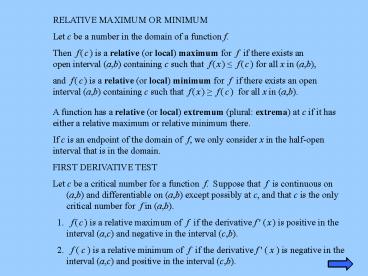RELATIVE MAXIMUM OR MINIMUM - PowerPoint PPT Presentation
1 / 7
Title:
RELATIVE MAXIMUM OR MINIMUM
Description:
Step 2. Set the first derivative equal to zero and solve. You must solve the ... Step 3. Draw a number line and locate the critical points (c) ... – PowerPoint PPT presentation
Number of Views:358
Avg rating:3.0/5.0
Title: RELATIVE MAXIMUM OR MINIMUM
1
RELATIVE MAXIMUM OR MINIMUM Let c be a number in
the domain of a function f. Then f ( c ) is a
relative (or local) maximum for f if there
exists an open interval (a,b) containing c such
that f ( x ) f ( c ) for all x in (a,b), and
f ( c ) is a relative (or local) minimum for f
if there exists an open interval (a,b) containing
c such that f ( x ) f ( c ) for all x in
(a,b).
A function has a relative (or local) extremum
(plural extrema) at c if it has either a
relative maximum or relative minimum there. If c
is an endpoint of the domain of f, we only
consider x in the half-open interval that is in
the domain.
FIRST DERIVATIVE TEST Let c be a critical number
for a function f. Suppose that f is
continuous on (a,b) and differentiable on (a,b)
except possibly at c, and that c is the only
critical number for f in (a,b). 1. f ( c )
is a relative maximum of f if the derivative f
' ( x ) is positive in the interval (a,c) and
negative in the interval (c,b). 2. f ( c ) is
a relative minimum of f if the derivative f ' (
x ) is negative in the interval (a,c) and
positive in the interval (c,b).
2
First Derivative TestProblem 1
1. Find the x-values of all points where the
following function has any relative maxima
or relative minima using the first derivative
test. Then find the value of any relative
maxima or relative minima writing the answers in
order pair form.
Step 1. Find the first derivative.
0
3
Step 2. Set the first derivative equal to zero
and solve. You must solve the
problem by factoring, using the quadratic
formula, or a combination of both.
The quadratic formula can only be used for
problems of ax 2 bx c 0
variety. Because of limited time, all problems
will be factorable. Some students
find it easier to use the quadratic formula.
x 0
CRITICAL NUMBERS The critical numbers for a
function f are those numbers c in the domain of
f for which f ' ( c ) 0 or f ' ( c ) does
not exist. A critical point is a point whose
x-coordinate is the critical number c, whose
y-coordinate is f ( c ).
4
Step 3. Draw a number line and locate the
critical points (c). This divides
the number line into several intervals.
Step 4. Pick a number from each interval,
substitute it into the first
derivative, determine if the value is positive
or negative, and indicate this on
the number line in step 3.
negative
positive
negative
positive
5
Step 5. Substitute each c into the original
equation and write as an ordered pair.
Step 6. Determine if c is a relative maximum or
relative minimum using the criteria
discussed on the first slide and step 4.
changing to means c is a relative
maximum changing to means c is
a relative minimum staying or
staying is called a point of inflection
Step 7. Make certain to write the final answers
in an acceptable form.
is a relative minima
Writing the answers in the order shown,
demonstrates the fact that between two minima's
there must be at least one maxima.
is a relative maxima
is a relative minima
6
There is enough information to sketch the graph
of the function.
Now compare this to the actual graph on the next
slide.
7
NOTE On slide five a statement about staying
or staying is called a point of inflection.
This happens when on both sides of the critical
point the function is either increasing or
decreasing. See the following examples.
Step 4.
Curvature opens up
Curvature opens up
Critical point
Curvature opens down































